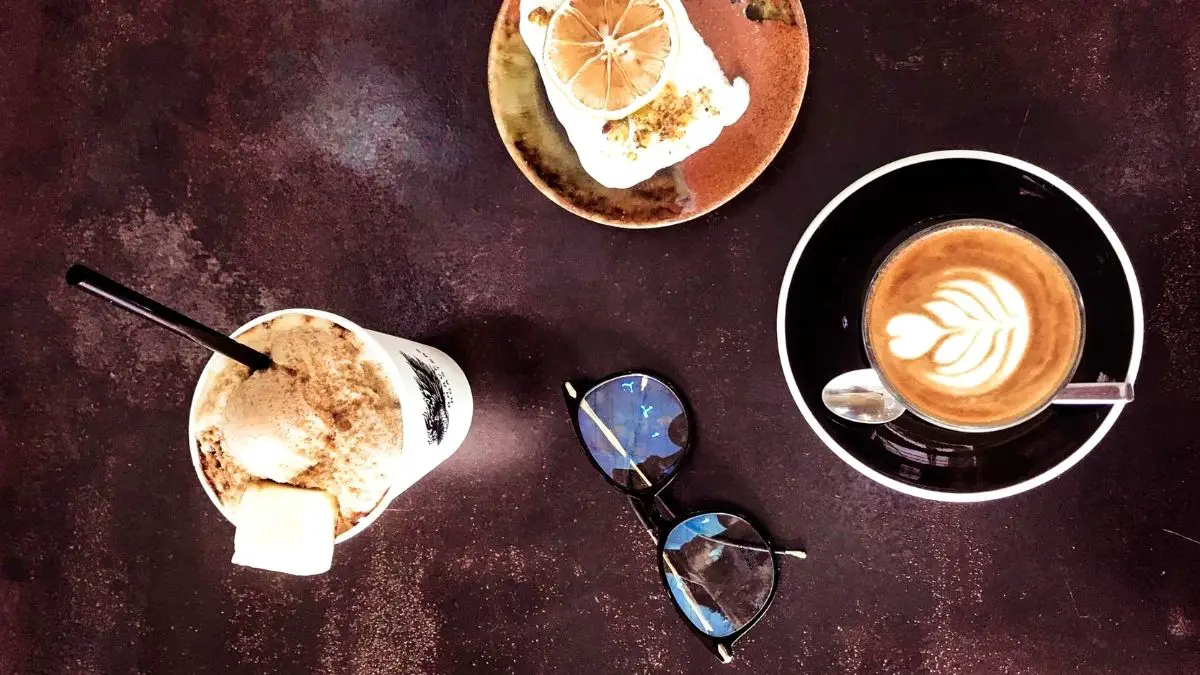They said mornings are not the same without a cup of your favorite coffee. This holds true even to this date, especially since there have been many types of coffee drinks that have evolved. Which one is your cup though? A frappuccino or a cappuccino?
But what’s the difference between these two?
A cappuccino is usually served hot in a small cup of about 150 ml to 180 ml in size and is espresso-based with steamed milk, and more frothed milk or microfoam. A frappuccino was introduced by Starbucks, typically served cold, and is coffee or creme-based blended with ice, and sweetened with flavoring syrups. Usually, it’s also served with toppings such as whipped cream, and other spices.
So if you are a hot or cold coffee person, you know which one you would choose. But let’s dig more into these two famous coffee drinks.
Frappuccino
The coffee giant Starbucks in 1995, officially sold frappuccinos after it acquired the rights from The Coffee Connection to create, use, and sell the coffee beverage. A portmanteau of “frappe” and “cappuccino”, the name frappuccino means frappe that derived from the French lait frappé, which is a milkshake with ice cream, and cappuccino, an espresso-based coffee drink with foamed or frothed milk, and sweetened with steamed milk.
Entrepreneur George Howell originally developed, named, and sold Frappuccinos, and was made by his then-employee Andrew Frank. Howell was a pioneer of a specialty-coffee group in the U.S. who founded the high-end coffee shop in Boston, The Coffee Connection. In 1994, Starbucks purchased The Coffee Connection and gained all the rights to trademark frappuccinos under its name.
In 1995, Starbucks started selling frappuccinos with different recipes.
The traditional frappuccinos are a fusion of coffee frap, which is almost similar to iced coffee, and the frappe, a combination of blended ice cream, milk, and syrup as well as the cappuccino. However, as the coffee industry evolves, different versions of frappuccino have also emerged, now usually with whipped cream. Starbucks currently offers these options below.
- Non-dairy options. For vegans and lactose-intolerant, getting a frappuccino isn’t an option, but Starbucks made it possible by introducing non-dairy alternatives. Now, you can have a frappuccino made with soy milk, almond, coconut, and oat milk in most Starbucks stores.
- Decaffeinated. A decaf frappuccino is also available at the customers’ request.
- Crème. Here’s a coffee-free version called Frappuccino Blended Crème with flavors such as Mocha Crème, Vanilla Bean Crème, Caramel Crème, Serious Strawberry Frappuccino, and Chocolate Frappuccino. These can be flavored or mixed with any syrup, spices, or sauce. A Crème Frappuccino contains zero to little caffeine.
- Modifications. In some Starbucks locations, a frappucino can be modified with possible charges such as adding flavored syrups and powders, chocolate chips, and espresso shots. You can also ask for a frappuccino with extra or light ice as well as with nonfat milk, low-sugar base, and without whipped cream.
The juice blends for frappuccinos were also made available from 2006 until 2008. Starbucks described it as an ice-blended real fruit extract with Tazo Tea. In 2017, its Unicorn Frappuccino went viral due to its “flavor-shifting, vibrantly hued, and color-changing.” However, it was only offered for a limited time as it was criticized because of too much sugar in it, which is considered unhealthy for both kids and adults.
Starbucks uses a powder form called Frap Roast, which is formulated for cold water usage. You can’t have it alone as the bitter taste isn’t ideal for a drink. However, it does better with other ingredients in making a frappuccino, especially its roasted aroma made from the Italian original roast.
Cappuccino
A cappuccino is an Austrian-Italian original coffee drink that’s made with a single or double shot of espresso, steamed milk, and a thick layer of microfoam or frothed milk. The name derived from Latin “Caputium” and was later modified into the German-Austrian term “Kapuziner“.
Cappuccio, an Italian term for “hood” from the shades of reddish-brown hooded robes of the nuns and monks of the Capuchin order that was inspired by Francis of Assisi’s vestments in the 13th century. The colors are what you can see in a cup of cappuccino.
While it’s traditionally served hot, many versions of the cappuccino have evolved, including one that’s served cold with added sweeteners like caramel or chocolate syrup. Apart from the traditional ones with latte art, cappuccinos also have different preparations. This includes the following:
- Iced Cappuccino. This coffee drink was made known in Canada by the Tim Hortons coffee shop, which is made from thick black syrup mixed at about three parts water to one part syrup using a Slurpee machine. It’s similar to iced coffee but blended with either milk, cream, or chocolate milk at the customer’s request. They call it Iced Capps and is available in the U.S. and Canada.
- Cappuccino Freddo. This is a cold version of a typical cappuccino usually served with a small amount of cold foamed milk at the top.
- Freddo Cappuccino. This is widely popular in Greece and Cyprus with different preparation and taste in spite of its Italian name. It’s also a cold version of a traditional cappuccino, but not readily available outside of Greece or in Italy. The drink is topped with aphrogala, a cold milk-based foam created using an electric frother. Starbucks even added this type of cappuccino drink to their menu in Europe.
Similar Drinks
- Cortado. This is a Spanish original coffee drink made with a mixture of espresso and milk without foamed milk. It’s served in a small glass.
- Caffè Macchiato. It’s made with espresso and a little amount of milk. Some people call it espresso macchiato.
- Flat White. This is common and widely popular in Australia and New Zealand that’s made from a double shot of milder espresso, no robusta, and with little to no foam. It’s also served with a little latte art on the top.
- Latte. This can also get a single or double shot of espresso but with more steamed milk, and frothed milk. It’s usually served in a bigger cup or glass.
- Babyccino / Baby-Cappuccino. This is intended for kids that originated in Sydney, Australia. It contains no caffeine with only 80% foamed milk and about 20% warm milk, sprinkled with a cacao powder. Others would put toppings like marshmallows.
What Is Espresso?
An espresso machine is responsible for brewing the espresso where a little amount of slightly boiling water is pressured through a compacted and finely-ground coffee. It’s of Italian origin and is used for making different coffee drinks such as caffè Americano, caffè macchiato, cappuccino, caffè mocha, flat white, and caffè latte.
Per unit volume, espresso contains more caffeine than most coffee drinks, but because it’s usually served smaller in size, its caffeine is usually less than a cup of standard brewed coffee. In Europe, espresso is widely used, particularly in Italy, Spain, Portugal, and France.
Caffeine Content
It really depends on how much caffeine you would want for your frappuccino. Each serving of frappuccino contains 65 mg of caffeine, but it can go as high as 190 mg depending on how much you need. A cup of cappuccino contains a single shot of espresso that has about 65 mg of caffeine and can be doubled when you get two shots.
On the other hand, frappuccinos can also be decaffeinated upon customers’ request. So it really depends on what you need when it comes to your favorite coffee drink.
Is Cappuccino Healthier Than Frappuccino?
Nutritional value-wise, a cappuccino has less added sugar or milk than a frappuccino, which means it’s lower in calories, fat, and protein. A traditional cappuccino has an even distribution of 1/3 steamed milk, 1/3 espresso, and 1/3 foamed milk with no added sugar. This means it can’t be any sweeter than a frappuccino.
For instance, a Mocha Cookie Crumble Frappuccino in venti size contains a whopping 76 g of sugar, which is equal to 15 teaspoons of sugar in a regular coffee. According to the American Heart Association (AHA), the recommended daily sugar intake should only be 24 g for women and 36 g for men. And a mocha frappuccino is even higher than the recommended intake.
So if you’re keeping count of your calories, a cappuccino is a better option. Otherwise, enjoying any size of a frappuccino isn’t too bad as long as you don’t do it every day.
The Bottom Line
Both cappuccino and frappuccino contain caffeine only with a difference in preparation, but they’re still great for a coffee drink. However, when we talk about the healthy side of things, a cappuccino gets the higher recommendation as it doesn’t contain added sugar or more milk in it because of its even distribution of ingredients.
A frappuccino, which is usually with added sweeteners tends to give you higher calories, and may not be your best option as a daily coffee drinker. However, if you’re only looking for a refreshing, delicious coffee beverage, a frappuccino would be great as it’s served cod with blended ice.
Whichever you prefer, it still pays to drink coffee in moderation.

